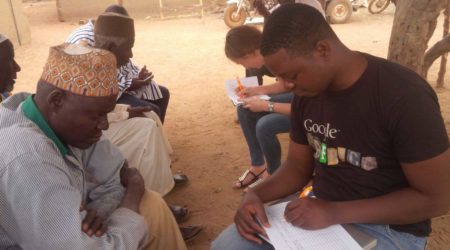Catalyzing an Ecosystem for Digital Finance for Climate Resilience

The UN-backed Race to Resilience campaign has committed to strengthening the climate resilience of 4 billion climate vulnerable people globally by 2030. Alongside the environmental risks that will inevitably come with climate change, there are additional risks that stem from the social, economic, and policy response to climate change – as well as calls for a “climate transition” (the transition to a greener economy). These will be compounded for those most vulnerable, who will need access to solutions that can help them build resilience in the face of such risks. However, this transition will simultaneously open up potential opportunities for these populations in the form of new income streams, products and services, and business models.
Solutions exist that can help vulnerable people to build resilience against the impact of climate change and take advantage of associated opportunities. But these solutions are not reaching those who need them most due to challenges with high upfront costs, distribution, risk perception by both users and providers, and limited data on end users. We believe digital finance and fintech can act as a critical enabler for climate resilience solutions, to help them overcome barriers to uptake related to affordability, access, and appropriateness for vulnerable populations. We’ve already seen the ways in which digital finance has enhanced the scale, depth, and reach of many other technologies targeting these populations, through similar industries like inclusive fintech and PayGo solar, and we believe they could play a similar role in the climate resilience space.
Catalyzing the innovation ecosystem
Few solutions exist today that combine innovation in digital finance and climate resilience. We believe a core reason for this is that the innovation ecosystem needed to enable the growth and development of these solutions remains fragmented and underdeveloped.
Innovation ecosystems include the people, processes, and systems necessary to deliver on the creation and scaling of new business models, products, and ideas. There are five key actors in an innovation ecosystem who are critical to its successful creation and development:
- Entrepreneurs and innovators
- Investors, funders, supporters
- Private sector incumbents and intrapreneurs
- Knowledge centers and universities
- Governments and policy makers
The current digital finance for climate resilience ecosystem, across five key actors
Entrepreneurs
In an initial search for pre-seed stage (Nigeria, South Africa, Kenya, India, and Mexico) we found:
- No companies explicitly state that they are a digital finance for climate resilience innovator
- Many core fintech or digital finance startups do enable resilience to some climate risks, or could enable climate resilience in the future with relatively small changes, considerations, and / or new partnerships
- We heard a variety of reasons why climate resilience was not an explicit focus:
- Many needed an explanation of what a climate resilience solution is and specifically how their business model could enable it
- There was not a clear or well-understood benefit to making this an explicit focus of the company
- In contrast, “calling yourself a fintech” opens companies up to massive amount of new funding sources, support programs, etc
- There aren’t clear opportunities associated with adding climate resilience as a focus, and there are clear business risks of not doing so. However, these are not yet known or recognized by entrepreneurs
- We heard a variety of reasons why climate resilience was not an explicit focus:
- Similarly, we found that core climate resilience startups typically have not yet considered embedding digital finance solutions
- In the few cases where entrepreneurs were considering climate resilience and climate change, many were focused on rural smallholder farmers, not on enabling the climate resilience of other vulnerable populations (i.e. urban poor or coastal populations) or on multiple points in the value chain
Investors, funders, supporters
- Globally, climate change is growing as a focus area for investors, donors, and supporters; however most focus specifically on clean tech and mitigation solutions. Less than 5% of climate finance (investment and donor capital) flows specifically into resilience solutions, and less than 2% globally can be used for either mitigation (emissions reduction) or resilience (multi-purpose).
- In emerging markets, due to a lack of shared understanding of investment theses and opportunities within climate products and services, capital is crowding around a limited number of business models in a few particular sectors. For example:
- In Africa in 2019, 167 startup funding deals were closed, for a total of $1.25B, with ~20% in climate solutions. Of those climate investments, 70% went to 9 later-stage companies in the off-grid solar sector.
- In contrast, fintech has received over $23B in funding since 2017, across a growing set of products. So there is an opportunity to leverage that investment capital for climate resilience solutions
- In emerging markets, due to a lack of shared understanding of investment theses and opportunities within climate products and services, capital is crowding around a limited number of business models in a few particular sectors. For example:
- A limited number of investors are beginning to look at climate resilience and digital finance as a thesis, including many fintech-focused investors looking for new opportunities for fintech to enable other sectors. In a scan of the market, we found that:
- There was not a common understanding of the definitions and terminology of the sector, nor commonly understood investment theses
- Many were unclear about the business models and products they should be investing in to help vulnerable populations build climate resilience
- Only recently have the first wave of “supporters” for innovation (incubators, accelerators) launched programs focused on tech-enabled climate change, agtech solutions, or climate smart agriculture (approaching the thesis of digital finance for climate resilience), including:
- Google Climate Change Accelerator
- Miller Center Climate Resilience Accelerator (theses: energy access, water, climate smart agriculture)
- Adaptation Fund Climate Innovation Accelerator
- Acumen Climate Resilience Ag Accelerator (India-focused)
- WASH Resilient Water Accelerator
- TechStars programs focused on climate (US-based)
- Climate Response Accelerator (New Zealand-based; theses: energy, water, waste)
- Even within these programs, many of the startups are focused on mitigation or on agricultural solutions for smallholders, and many are only focused on developed markets. Many also don’t list particular investment thesis areas to target
- Funders also seem more likely to focus on mitigation and clean tech, due to a variety of factors:
- Much of the donor funding in emerging markets comes from developed, Western economies where mitigation is the key challenge, rather than resilience
- Mitigation is more straightforward to address than resilience:
- Most solutions are tech-based, and focused on a specific challenge, sector, or technology
- Impact measurement is easier, most often simply a measure of CO2 offset or reduction
- In contrast, a complicated system of factors influences a person’s ability to adapt to climate change, and measuring impact and designing interventions is complex and fraught with externalities
- A few large donors we have spoken with are in the process of developing their climate resilience strategies and plan to announce them around COP26
- Funders (donors, investors, and supporters) are siloed in their theses and support areas, so they find it difficult to invest in a new “nexus”:
- Many have multiple theses, including separate theses on climate or agriculture and financial health or digital finance, but very few are able to invest or support projects that cut across both
- For most funders, these two theses sit in separate teams within the organization, so there may be limited flow of information or a lack of common understanding of terminology and opportunity for collaboration
Private sector incumbents and intrapreneurs
- Few large organizations, including those in digital finance, climate, or adjacent sectors like agriculture, have recognized and are acting on the potential to enable climate resilience via digital finance:
- Many fintech and financial service providers are already serving low-income and climate-vulnerable populations, but are not yet thinking about how their products and services can enable climate resilience for their existing customer segments or open up new opportunities for value creation, cross-selling, and improved stickiness
- For example, Tala is one of the largest digital lenders for low-income segments globally. They have served over 1.3M users, and it’s likely that many of these users are climate vulnerable
- Tala has not publicly announced or acknowledged the potential of their products and services to improve climate resilience and has not publicly announced the addition of products or services to their offering that address climate resilience
- Tala also has not publicly acknowledged that climate change is likely to pose a risk to their model. Climate disasters and changes may make it difficult for low-income segments to repay loans in the short term, or may make certain segments and geographies more risky to serve. Climate change will pose these and other risks to many fintech companies’ business models, but many do not yet recognize or understand the risks and ways in which they could adapt and also leverage the opportunity
- Large organizations serving climate vulnerable populations, such as One Acre Fund and MercyCorps, have begun exploring the potential for digital technologies and digital finance to enable climate resilience among the populations they serve, but they lack the infrastructure, data, and business model enablers to deploy solutions at scale, or may not have an understanding of the potential for digital finance to enable scale of solutions
- Many fintech and financial service providers are already serving low-income and climate-vulnerable populations, but are not yet thinking about how their products and services can enable climate resilience for their existing customer segments or open up new opportunities for value creation, cross-selling, and improved stickiness
- DFS players are siloed from climate players, so they don’t understand the need for climate resilience solutions or the terminology and foundational research and definitions already defined by the climate sector
Knowledge centers and universities
- A few think tanks and knowledge hubs are beginning to publish blogs and insights on the potential for digital finance to unlock scale for climate resilience solutions, including recent blog posts by CGAP and WRI’s upcoming investment blueprint for of Digital Climate Advisory Services
- Digital finance players are just starting to explore this opportunity because they’re looking for new ways to apply their solutions, but it is often done in a silo from climate players (not in collaboration with climate players)
- There are a lot of press and opinion pieces like blogs about the potential for fintech and digital finance to impact climate resilience, but not definitive or technical products with conclusive insights or evidence about the market
- Most reports attempting to understand the power of fintech and digital finance for climate solutions are targeted at cleantech and developed markets
- New Energy Nexus in 2020 released a report titled What is Climate Fintech that attempts to define the sector; however it is focused primarily on developed markets and on mitigation solutions
- Rise by Barclays recently (May 2021) also released a report on climate fintech, but focused on clean tech solutions and the green economy rather than resilience
Governments and policy makers
- Investment and policy are largely focused on delivering on the Nationally Determined Contributions (NDCs) agreed upon at COP21 in 2015
- The NDCs include both commitments to mitigation and resilience, but most action until now has been focused on mitigation
- Where there is action on resilience, it’s mainly on larger infrastructure projects rather than on delivering resilience solutions to vulnerable populations
- There is a large focus on climate risk assessment and modeling for financial institutions and central banks
- There is little understanding of the investment required to enable infrastructure for climate transition (i.e. electricity infrastructure to enable transition to electric vehicles)
- Regulators are still catching up on fintech, including regulations for cryptocurrencies, blockchain, etc. As a result, they are not proactively exploring new asset classes to be regulated
- Climate and financial regulation and policy are still largely siloed – there is little broader inter-ministerial coordination and alignment moving beyond the Central Bank, to include Environment, Interior, or other relevant ministries in enabling ‘sandboxes’ and other initiatives
- A few working groups involving all of the financial and fiscal market authorities (ie, central bank, securities, finance and treasury) to proactively coordinate and align priorities while respecting lines of independence are emerging, but still limited
The opportunity in this space is significant, and its urgency is only growing as the impact of climate change on vulnerable populations becomes increasingly evident. We’ve already seen this growth trajectory play out in other impact sectors – including inclusive fintech, PAYGo solar, mobile money, and microfinance. Armed with these lessons and proof points, and given the right enablers and substantial commitments from key players, this ecosystem has the power to develop quickly and catalyze real and impactful innovation.
The common enablers and critical interventions we found when evaluating other ecosystems and the early stages of their development include:
- Pioneering entrepreneurs who develop new value propositions to solve new problems, and a few “champion” startups who emerge as examples to create interest and excitement
- Philanthropic, catalytic capital to fund those early pioneers, in many cases flowing from adjacent sectors
- Once philanthropic capital has been used to provide some early traction and proof points, impact investors are needed to bring more funding to the field aiming to scale ventures
- Think tanks and knowledge hubs recognize the potential of the innovations and help to define the new paradigm with seminal research and reports
BFA Global is leading the process to develop a Framework for Action, designed in collaboration with key stakeholders, that will be critical to the development of this ecosystem. We are setting out to:
- Define a common language to discuss and engage with digital finance for climate resilience solutions
- Provide a comprehensive analysis of the solution space, including high-potential business models, products, and services and pathways to scale
- Identify and amplify high-potential innovations and “champion” providers, to drive awareness and excitement among entrepreneurs, investors, donors, and the private sector
- Chart a roadmap for specific action for each of the five actors in the innovation ecosystem, so they can play their part in its development
The framework will be launched at COP26, in collaboration with the UN-backed Race to Resilience campaign, along with commitments to act in accordance with the roadmap by organizations across the five key actors described above.
In the coming months, we will continue to unveil elements of our work via blog posts and events. We are looking for contributors, supporters, and collaborators — such as investors and funders interested in digital finance for climate resilience as a thesis, digital finance innovators curious about how they could impact climate resilience, or think-tanks interested in co-exploration — to join our process and co-lead the creation of a sector that we believe can substantially move the needle on access to climate resilience solutions for the world’s most vulnerable populations.
Join our session during London Climate Week to meet some of our collaborators and hear more about our work.
For more information about this work or to get involved please contact us:



